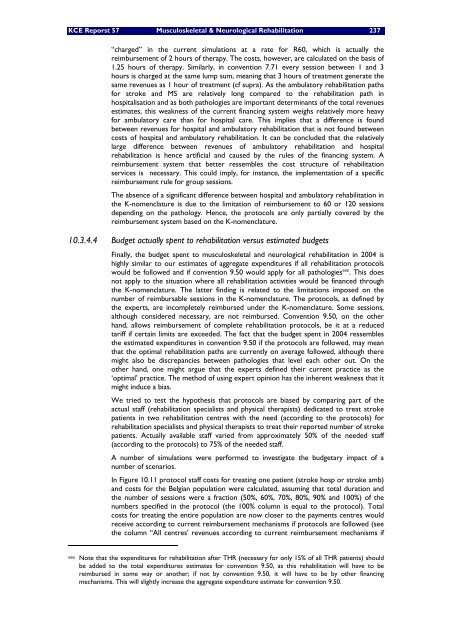The report is available in English with a French summary - KCE
The report is available in English with a French summary - KCE
The report is available in English with a French summary - KCE
Create successful ePaper yourself
Turn your PDF publications into a flip-book with our unique Google optimized e-Paper software.
<strong>KCE</strong> Reporst 57 Musculoskeletal & Neurological Rehabilitation 237<br />
“charged” <strong>in</strong> the current simulations at a rate for R60, which <strong>is</strong> actually the<br />
reimbursement of 2 hours of therapy. <strong>The</strong> costs, however, are calculated on the bas<strong>is</strong> of<br />
1.25 hours of therapy. Similarly, <strong>in</strong> convention 7.71 every session between 1 and 3<br />
hours <strong>is</strong> charged at the same lump sum, mean<strong>in</strong>g that 3 hours of treatment generate the<br />
same revenues as 1 hour of treatment (cf supra). As the ambulatory rehabilitation paths<br />
for stroke and MS are relatively long compared to the rehabilitation path <strong>in</strong><br />
hospital<strong>is</strong>ation and as both pathologies are important determ<strong>in</strong>ants of the total revenues<br />
estimates, th<strong>is</strong> weakness of the current f<strong>in</strong>anc<strong>in</strong>g system weighs relatively more heavy<br />
for ambulatory care than for hospital care. Th<strong>is</strong> implies that a difference <strong>is</strong> found<br />
between revenues for hospital and ambulatory rehabilitation that <strong>is</strong> not found between<br />
costs of hospital and ambulatory rehabilitation. It can be concluded that the relatively<br />
large difference between revenues of ambulatory rehabilitation and hospital<br />
rehabilitation <strong>is</strong> hence artificial and caused by the rules of the f<strong>in</strong>anc<strong>in</strong>g system. A<br />
reimbursement system that better ressembles the cost structure of rehabilitation<br />
services <strong>is</strong> necessary. Th<strong>is</strong> could imply, for <strong>in</strong>stance, the implementation of a specific<br />
reimbursement rule for group sessions.<br />
<strong>The</strong> absence of a significant difference between hospital and ambulatory rehabilitation <strong>in</strong><br />
the K-nomenclature <strong>is</strong> due to the limitation of reimbursement to 60 or 120 sessions<br />
depend<strong>in</strong>g on the pathology. Hence, the protocols are only partially covered by the<br />
reimbursement system based on the K-nomenclature.<br />
10.3.4.4 Budget actually spent to rehabilitation versus estimated budgets<br />
F<strong>in</strong>ally, the budget spent to musculoskeletal and neurological rehabilitation <strong>in</strong> 2004 <strong>is</strong><br />
highly similar to our estimates of aggregate expenditures if all rehabilitation protocols<br />
would be followed and if convention 9.50 would apply for all pathologies eee . Th<strong>is</strong> does<br />
not apply to the situation where all rehabilitation activities would be f<strong>in</strong>anced through<br />
the K-nomenclature. <strong>The</strong> latter f<strong>in</strong>d<strong>in</strong>g <strong>is</strong> related to the limitations imposed on the<br />
number of reimbursable sessions <strong>in</strong> the K-nomenclature. <strong>The</strong> protocols, as def<strong>in</strong>ed by<br />
the experts, are <strong>in</strong>completely reimbursed under the K-nomenclature. Some sessions,<br />
although considered necessary, are not reimbursed. Convention 9.50, on the other<br />
hand, allows reimbursement of complete rehabilitation protocols, be it at a reduced<br />
tariff if certa<strong>in</strong> limits are exceeded. <strong>The</strong> fact that the budget spent <strong>in</strong> 2004 ressembles<br />
the estimated expenditures <strong>in</strong> convention 9.50 if the protocols are followed, may mean<br />
that the optimal rehabilitation paths are currently on average followed, although there<br />
might also be d<strong>is</strong>crepancies between pathologies that level each other out. On the<br />
other hand, one might argue that the experts def<strong>in</strong>ed their current practice as the<br />
‘optimal’ practice. <strong>The</strong> method of us<strong>in</strong>g expert op<strong>in</strong>ion has the <strong>in</strong>herent weakness that it<br />
might <strong>in</strong>duce a bias.<br />
We tried to test the hypothes<strong>is</strong> that protocols are biased by compar<strong>in</strong>g part of the<br />
actual staff (rehabilitation special<strong>is</strong>ts and physical therap<strong>is</strong>ts) dedicated to treat stroke<br />
patients <strong>in</strong> two rehabilitation centres <strong>with</strong> the need (accord<strong>in</strong>g to the protocols) for<br />
rehabilitation special<strong>is</strong>ts and physical therap<strong>is</strong>ts to treat their <strong>report</strong>ed number of stroke<br />
patients. Actually <strong>available</strong> staff varied from approximately 50% of the needed staff<br />
(accord<strong>in</strong>g to the protocols) to 75% of the needed staff.<br />
A number of simulations were performed to <strong>in</strong>vestigate the budgetary impact of a<br />
number of scenarios.<br />
In Figure 10.11 protocol staff costs for treat<strong>in</strong>g one patient (stroke hosp or stroke amb)<br />
and costs for the Belgian population were calculated, assum<strong>in</strong>g that total duration and<br />
the number of sessions were a fraction (50%, 60%, 70%, 80%, 90% and 100%) of the<br />
numbers specified <strong>in</strong> the protocol (the 100% column <strong>is</strong> equal to the protocol). Total<br />
costs for treat<strong>in</strong>g the entire population are now closer to the payments centres would<br />
receive accord<strong>in</strong>g to current reimbursement mechan<strong>is</strong>ms if protocols are followed (see<br />
the column “All centres' revenues accord<strong>in</strong>g to current reimbursement mechan<strong>is</strong>ms if<br />
eee Note that the expenditures for rehabilitation after THR (necessary for only 15% of all THR patients) should<br />
be added to the total expenditures estimates for convention 9.50, as th<strong>is</strong> rehabilitation will have to be<br />
reimbursed <strong>in</strong> some way or another; if not by convention 9.50, it will have to be by other f<strong>in</strong>anc<strong>in</strong>g<br />
mechan<strong>is</strong>ms. Th<strong>is</strong> will slightly <strong>in</strong>crease the aggregate expenditure estimate for convention 9.50.

















